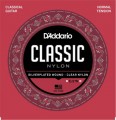Braid shape
— Round. The classic version, which appeared first and still does not lose popularity due to its simplicity, low cost and functionality. From an acoustic point of view, the
round braid contributes to the sonority of the sound. When sliding your fingers along such a string, a characteristic “buzz” occurs, but for many guitarists this is not a disadvantage, and some even use this sound as an additional playing technique.
— Flat. Flatwound strings have an almost flat surface with only the characteristic spiral pattern between the turns. Other things being equal,
flat winding, compared to round winding, gives a softer, warmer, perhaps even slightly muffled tone of sound. Also, such strings allow you to perform more "clean" slides, without a buzzing sound when you move your finger along the string, and wear out the frets less.
— Semi-flat. To obtain such a winding, a round wire is used, which, during processing, is smoothed from the outside. Thus, a
semi-flat winding is a kind of middle option between flat and round: flat on the outside, round on the inside. Thanks to this, it combines many advantages of a flat braid (“careful attitude” to the frets, no noise when sliding a finger) with a rather sonorous sound.
—
Elliptical. The winding of this type in the section has a slightly flattened shape, however, unlike the se
...mi-flat, its surface is closer to the usual round winding, and the turns are quite pronounced. In fact, the "ellipse" is a modification of the round winding, designed to reduce fret wear and at the same time preserve the sonorous and clear sound as much as possible.String diameter
The diameter of the strings in the set, from thinnest to thickest.
Thicker strings, all other things being equal, provide more volume and richness to the sound, have more overtones, and generally sound richer and warmer (high frequencies are less pronounced in the sound). However, these strings require more tension, which can make them uncomfortable for beginners and inexperienced players who are unaccustomed to high force; and the duration of the sound is relatively low. Conversely, thinner strings are softer to the touch, require less effort, give better sustain, but are thinner and more prone to rattle. Detailed recommendations on the optimal string thickness for different cases can be found in special sources (including documentation for the instrument itself and reference materials from string manufacturers).
Note that the diameter of the strings is directly related to the tension (see below), so one of these parameters is often indicated in the characteristics.
Tension
The tension is directly related to the diameter of the strings (see above) — thicker strings have to be stretched more. Thus, the characteristics often indicate only one of these parameters (either thickness or tension). And the list of tension options, from weakest to strongest, looks like this:
— Extra super light;
—
Extra light ;
—
Super light ;
—
Easy ;
—
Average ;
—
Heavy ;
— Extra heavy.
In bowed instruments, the set of options is noticeably more modest, it includes soft (extra super light), medium and hard (heavy) tension.
In general, the "lighter" the strings are, the softer they are to the touch, and the easier they are to play. In addition, a relatively low tension gives good sustain (duration) and melodiousness of the sound. At the same time, loosely stretched strings have a thin and relatively quiet sound, and they are more likely to rattle. And vice versa, as the tension increases (and thickness increases), the sound becomes more powerful, rich, “warm”, high frequencies stand out less in it; however, the force required to compress the strings also increases accordingly.
In light of all this, for beginners, mastering the guitar, the most "light" sets are recommended — they will not cut their fingers much and make it easier to ge
...t used to. But beginner violinists should choose medium-tension sets — it is best to work out the basic playing techniques on them, and only after that, if you want, you can pay attention to hard or soft strings.
Note that there are "combined" sets of strings on the market, marked with different tensions — for example, " super light / light ", " light / heavy ", etc. In such sets, thin strings have a lighter tension than thick ones: for example, 1-2-3 strings are "light", 4-5-6 are "medium". This allows you to achieve a combination of ringing high frequencies with tight and rich bass; although the specific coloration of the sound will, of course, depend on the combination of tensions.
